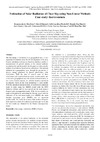Identificador persistente para citar o vincular este elemento:
https://accedacris.ulpgc.es/jspui/handle/10553/25468
| Campo DC | Valor | idioma |
|---|---|---|
| dc.contributor.author | Díaz Perez, F.J. | en_US |
| dc.contributor.author | Chinarro, D. | en_US |
| dc.contributor.author | Mouhaffel, A.G. | en_US |
| dc.contributor.author | Díaz Martín, R. | en_US |
| dc.contributor.author | Mayoral, Jesús Romero | en_US |
| dc.contributor.author | El-Hilo, M. | en_US |
| dc.contributor.author | Martínez Domínguez, C. | en_US |
| dc.contributor.author | Otín, M.R.P. | en_US |
| dc.date.accessioned | 2018-02-08T03:30:20Z | - |
| dc.date.accessioned | 2018-06-07T07:23:23Z | - |
| dc.date.available | 2018-02-08T03:30:20Z | - |
| dc.date.available | 2018-06-07T07:23:23Z | - |
| dc.date.issued | 2017 | en_US |
| dc.identifier.issn | 0973-4562 | en_US |
| dc.identifier.uri | https://accedacris.ulpgc.es/handle/10553/25468 | - |
| dc.description.abstract | The knowledge of irradiation in a geographical area is very important for multiple areas for the development of the area. Current calculation systems are based on statistical models of measurements of ground stations, or by external radiation calculations by satellite models. In this paper we show another method of calculation, based on the estimation of the incident radiation in a geographical area, through the production of electric energy generated by known photovoltaic solar installations. | en_US |
| dc.format | application/pdf | es |
| dc.language | eng | en_US |
| dc.relation.ispartof | International Journal of Applied Engineering Research | en_US |
| dc.rights | by-nc-nd | es |
| dc.source | International Journal of Applied Engineering Research [ISSN 0973-4562], v. 12 (24), p. 15438-15446 | en_US |
| dc.subject | 3306 Ingeniería y tecnología eléctricas | en_US |
| dc.subject.other | Solar energy | en_US |
| dc.subject.other | Irradiation | en_US |
| dc.subject.other | ARIMA | en_US |
| dc.subject.other | Fourier | en_US |
| dc.title | Estimation of solar radiation of clear sky using non-linear methods case study: Fuerteventura (Spain) | en_US |
| dc.type | info:eu-repo/semantics/Article | en_US |
| dc.type | Article | en_US |
| dc.identifier.scopus | 85041040143 | - |
| dc.contributor.authorscopusid | 57194222019 | - |
| dc.contributor.authorscopusid | 55373045100 | - |
| dc.contributor.authorscopusid | 56548972200 | - |
| dc.contributor.authorscopusid | 56673223000 | - |
| dc.contributor.authorscopusid | 57188829116 | - |
| dc.contributor.authorscopusid | 57200383633 | - |
| dc.contributor.authorscopusid | 7004606724 | |
| dc.contributor.authorscopusid | 57192924424 | - |
| dc.contributor.authorscopusid | 55199527500 | - |
| dc.identifier.crisid | -;-;-;-;2179;-;-;- | - |
| dc.description.lastpage | 15446 | - |
| dc.identifier.issue | 24 | - |
| dc.description.firstpage | 15438 | - |
| dc.relation.volume | 12 | - |
| dc.investigacion | Ingeniería y Arquitectura | en_US |
| dc.rights.accessrights | info:eu-repo/semantics/openAccess | es |
| dc.type2 | Artículo | en_US |
| dc.identifier.external | 2179 | - |
| dc.date.coverdate | Enero 2017 | |
| dc.identifier.ulpgc | Sí | es |
| dc.description.sjr | 0,199 | |
| dc.description.sjrq | Q3 | |
| item.fulltext | Con texto completo | - |
| item.grantfulltext | open | - |
| crisitem.author.dept | Departamento de Ingeniería Eléctrica | - |
| crisitem.author.orcid | 0000-0003-1403-5645 | - |
| crisitem.author.fullName | Romero Mayoral, Jesús | - |
| Colección: | Artículos | |
Visitas
40
actualizado el 10-ene-2026
Descargas
22
actualizado el 10-ene-2026
Google ScholarTM
Verifica
Comparte
Exporta metadatos
Los elementos en ULPGC accedaCRIS están protegidos por derechos de autor con todos los derechos reservados, a menos que se indique lo contrario.
